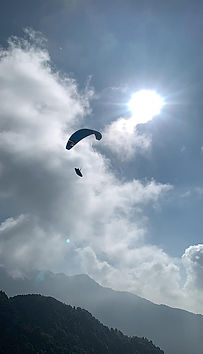History of Paragliding
Short history of paragliding
Paragliding as we know it began in the 1960s and 70s, when climbers and pilots experimented with modified parachutes to glide down mountains. In 1978, three French pioneers—Jean-Claude Bétemps, André Bohn, and Gérard Bosson—made the first true paraglider flights from the steep slopes of Mieussy, France. This moment marked the birth of modern paragliding.
During the 1980s, the sport rapidly evolved with better fabric, improved wing shapes, and safer control systems, transforming paragliding into a globally recognised form of free-flight aviation. By the 1990s, paragliding schools, competitions, and training programs emerged around the world, making the sport accessible to adventure enthusiasts, travellers, and professional pilots.
Today, paragliding is one of the most popular forms of aerial adventure, attracting flyers to scenic coastal locations, mountain ranges, and ridge-soaring sites across India and the world.

Evolution of paragliding equipment
Paragliding equipment has evolved dramatically since the sport began in the late 1970s. Early paragliders were simple, modified parachutes with limited glide performance and basic controls. As pilots demanded better safety and efficiency, designers introduced elliptical wing shapes, lighter fabrics, and improved line configurations through the 1980s and 90s.By the 2000s, advances in aerodynamics brought high-performance wings, EN-certified gliders for every skill level, and durable-yet-lightweight materials like ripstop nylon and Dyneema lines. Modern paragliders now offer exceptional stability, precise handling, and enhanced passive safety—allowing pilots to fly longer, higher, and more confidently. Today’s paragliding gear also includes advanced harnesses with built-in back protection, reserve parachutes, flight instruments (varios, GPS, and trackers), and certified helmets—all designed to make the experience safer and more accessible for both new and experienced solo pilots. This continuous evolution has made paragliding one of the safest and most exciting adventure sports, attracting flyers to beautiful sites like Alibaug located just south of Mumbai, where enthusiasts come to learn paragliding in Alibaug and train with professional instructors at local paragliding schools near Mumbai.


History of paragliding in India.
Paragliding began taking shape in India in the early 1990s, when adventure tourism started growing in the Himalayan regions. Himachal Pradesh became the birthplace of Indian paragliding, with places like Bir Billing emerging as the country’s first major free-flying sites. Early foreign pilots helped train local enthusiasts, leading to the establishment of India’s first structured paragliding clubs and schools.
By the 2000s, organized training, safety standards, and competitions such as the Paragliding World Cup Pre-Events at Bir Billing brought international attention to India’s flying conditions. As awareness grew, new flying locations developed across the Western Ghats, Maharashtra, Karnataka, and Uttarakhand.
In Maharashtra, coastal, ridge-soaring, thermal flying and cross-country sites gained popularity, especially around Alibaug, attracting students and pilots looking for weekend paragliding training close to the city. Today, India has a thriving paragliding community with improved equipment, experienced instructors, and a growing number of paragliding schools near Mumbai and across the country.
History of paragliding in Alibaug
Paragliding in Alibaug began growing organically in the early 2000s, when pilots from Mumbai and Maharashtra started exploring the Western Ghats and coastal ridges for new flying sites. With its steady sea breeze, gentle ridgelines, and open coastal terrain, Alibaug quickly became recognised as one of the most promising locations for coastal free-flying near Mumbai.
As interest in the sport increased across Maharashtra, Alibaug evolved from an informal exploratory site into a regular training and flying destination. Pilots began identifying reliable take-off points around Kankeshwar, Kashid, Revdanda, and the surrounding hill ranges—areas known for smooth wind conditions and beautiful ocean-facing flights.
Over time, structured training, safety practices, and professional instruction contributed to the development of paragliding as a recognised adventure activity in the region. Today, Alibaug stands out as one of the closest and most accessible coastal flying sites for Mumbai-based students, with paragliding schools in Alibaug offering beginner courses, progression training, and guided flights for enthusiasts from across India.
Alibaug’s unique combination of coastal winds, scenic landscapes, and proximity to Mumbai has helped establish it as a growing hub for paragliding near Mumbai, attracting pilots who want to learn paragliding in Alibaug in a safe and natural environment.





